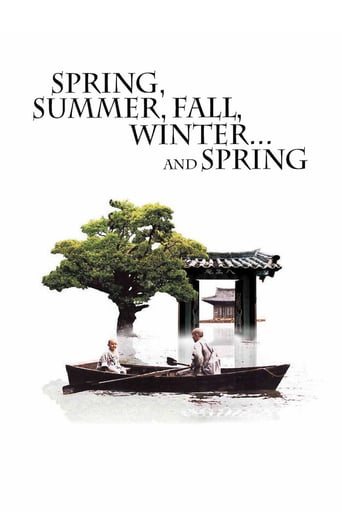tiagoponte-399-905213
I did not read to much into the symbols and rather just appreciated the movie for what it was. Beautiful in it's cinematography, and it spoke to me on a personal level at the time I watched it.
Not sure if I would recommend it to everyone, but I - for one - did enjoy it very much.
classicsoncall
The seasons are allegorical, the movie follows the life of a young boy on the way to manhood under the watchful eye of his Master. I found the wisdom of the Master to be guardedly accurate, EXCEPT when he made the observation to Young Adult Monk that's in my summary above. The Master's statement has the effect of making his observation inevitable for the Young Adult Monk as he sets out into the 'world of men'.Obviously, this didn't have to be. But a young man who cannot control his passions, even over the infidelity of a wife, is still accountable for his actions if they result in murder. The crime the Young Adult Monk committed is troubling within the context of the story because it seems to me he should have learned something from his Master over the years to make his life more productive. He expressed remorse as a Boy Monk when he tortured the animals with a stone. The Master taught him a valuable lesson about carrying the weight of a stone in his heart for the damage he had done to one of God's creatures.Fortunately, the Young Adult Monk was made to repay society for his crime. It would have been inappropriate for him not to face justice. But when he returns as The Adult Monk, he returns with the same heart of stone he left with, and pursues self tribulation to cleanse his heart of it's guilt. The disgraced mother who brings her out of wedlock child to The Adult Monk symbolizes the way he himself may have arrived at the floating monastery to be placed under the care of the original Master. So describes the arc of the seasons in a person's existence, though in this case, one of pain and sorrow instead of joy and fulfillment. In another more uplifting film, this would have been called the Circle of Life.To my mind, the picture would have been more fitting to convey a positive attitude with a positive outcome, but of course, life isn't often scripted that way. Considering that, the film offers an excellent cinematic experience, with the change of the seasons displayed in a vibrant array of textures and colors. This was my second viewing of the movie, and I found that it had gained greater resonance for me than the first time I watched it a number of years ago.
Kirpianuscus
it is the first word for define it. because it is a not ordinary beauty. but a sort of trip in spiritual air. its gracious simplicity, its moral lessons, who define each religious attitude, its delicacy, the flavor of images, the ways of the young disciple and the presence of the master, the temptation and the joy, the precise manner to suggest more than present, the bitter temptation and the return are pieces of a fascinating work. and this does the film an event. or a precious seed for useful memories. because all is a form of reflection of the viewer. because each scene becomes a chance to discover yourself. like in a large mirror who discovers the hidden side of yourself. short, a film who must see. for remind old impressions about Extreme East. or for escape from the every day pressure and the temptations of media.
Siamak Zahmat
A movie astonishing in its beautiful portrayal of the nature through all the four seasons. Thought-provoking in its message of the journey of the hero: from joy and pleasure to lust, desire and anger. And finally coming full circle with redemption and contemplation.The movie is indeed universal, as it shows the circle of life and the circle of the seasons. But there are many spiritual meanings to be found if you dig deeper and recognize the Buddhist signs. It's a timeless masterpiece and a must-see film for everyone above the age of 16. It's not held back by a complex plot or difficult dialogues. It's simple, yet full of wisdom.



